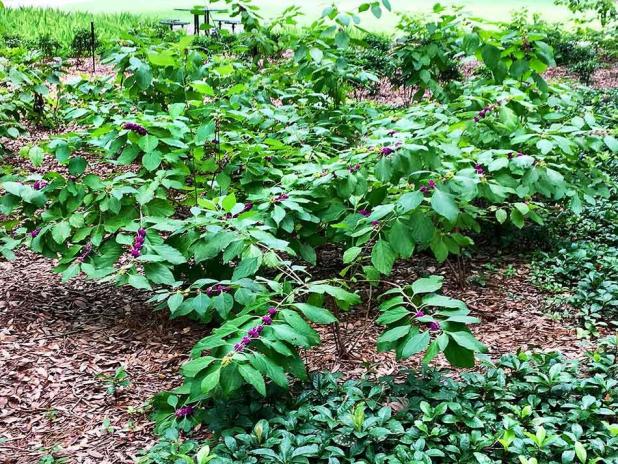
Use native plants such as American beautyberry or adapted plants that need little inputs for more sustainable landscape plant choices.
—LSU AgCenter/Heather Kirk-Ballard
Get It Growing: Celebrate Earth Day every day
April is such a busy time in the garden. It’s also when we celebrate Earth Day which was held April 22. What better time to reflect on how we as gardeners can help preserve our planet for future generations than now?
We can do many things to help minimize our impacts to the environment in the way that we care for our landscapes.
According to the Pesticide Action Network of North America, each year, an estimated 1 billion pounds of pesticides are applied to U.S. farms, forests, lawns and golf courses, with more than 17,000 pesticide products currently on the market. Worldwide, 5.6 billion pounds of pesticides are used each year.
In general, landscapes that use highly cultivated plants require more chemical inputs such as fertilizers, pesticides and herbicides.
As an example, lawns of highly cultivated grasses such as hybrid Bermuda require six times the recommended amount of nitrogen fertilizer when compared to low-input options such as carpetgrass. Roses — along with many other highly cultivated and non-native plants — can require extensive spray programs to reduce disease, and they often require heavy fertilizer use for their best performance.
There are risks associated with high pesticide concentrations found in water in urban and suburban areas. According to the U.S. Geological Survey, these areas have higher concentrations of pesticides than agricultural areas in water quality monitoring data.
Nonpoint source pollution is how drinking water and ecosystems can become contaminated from rain that moves over both residential and agricultural land, picking up and carrying away excess fertilizers, herbicides and pesticide pollutants to water sources. The exponential increase in urban populations and non-permeable surfaces has made storm water runoff one the fastest growing sources of pollution.
Not only is our water a concern, but so are pollinators, beneficial insects and honeybees in addition to human pesticide exposure incidents.
Here’s the good news: You can make choices that make a difference. By using sustainable landscaping practices, you can still design an attractive landscape that is functional, low maintenance, cost efficient and environmentally friendly.
A sustainable landscape finds balance with the local climate; reduces inputs such as chemical fertilizers, herbicides, fungicides and pesticides; and promotes energy and water management for a healthier environment that can help improve both air and water quality.
Sustainable landscapes reduce inputs that can also save consumers time and money in contrast to traditional landscapes that rely heavily on highly cultivated plants. The focus of sustainable landscaping is the mindful choices of low-input plants, environmentally friendly hardscapes and gardening techniques that maximize the value of your home as well as the environment.
Planning is the first rule of sustainable landscaping. Plant selection is the first stop. Choosing plants that are native and highly adapted to our climate is key.
Once established, these plants will have reduced water, fertilizer, pesticide and time requirements. Adapted plants such as drought-tolerant plants require less water and those that are insect- and disease-resistant will require less spraying. Native plants naturally thrive in local ecosystems.
Use annuals and turfgrass in small areas, and maintain with them minimal inputs. Walkways should be constructed of water-permeable surfaces such as crushed granite, pea gravel or other types of gravel or water-permeable materials.
Keep up with weeding. By ensuring your plants are healthy and vigorously growing, they easily outcompete the weeds. Replace mulch seasonally and as needed to reduce weeds. In addition, groundcovers can be used for effective weed control. Lastly, hand pull weeds often.
Reduce the amount of turfgrass you have. Lawns require mowing, fertilizing and more water than most other landscape plants. In addition, many lawns suffer from fungal diseases such as large patch and gray leaf spot that require fungicide treatment.
Moreover, if you remember the sod webworm problem last year, you understand how lawns require a great deal of inputs such as time and chemicals that can be very expensive and are not environmentally friendly.
If you just love the lawn, help reduce your impact by raising your lawn mower blade to prevent the need for more water. Mowing your lawn too short promotes vigorous new growth that requires more water. Longer grass promotes deeper root growth and a more drought resistant lawn. In addition, it prevents the growth of weeds.
Groundcovers can be used to replace turfgrass lawns. They require a lot less upkeep. Some groundcovers such as monkey or mondo grass (Ophiopogon japonicas), creeping lily-turf (Liriope spicata) and Asian jasmine (Trachelospermum asiaticum) have been used to replace turfgrass lawns. There are also native options such as wild strawberry (Fragaria virginiana), common blue violet (Viola sororia) and creeping phlox (Phlox stolonifera).
With proper plant selection, mowing, responsible use of chemicals and good weed management, you can help reduce environmental pollution and help preserve the Earth for future generations.
